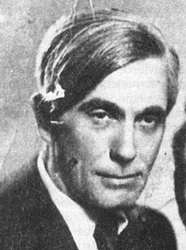NAGY, Oszkár
(1893, Magyarpécska - 1965, Nagybánya)


Since his youth Oszkár Nagy's oeuvre was closely connected to the Nagybánya artists' colony. He was brought up only by his mother but often he spent some time with relatives or in "strange" places. He did his primary school studies in Arad and took his final grammar school exams in Lugos.
He had been fond of drawing since childhood and called himself the best "drawer" in the school in one of his curriculum vitaes. After leaving school he took up a job as an office clerk (for his mother's sake) but instead of plans it was chiefly drawings of his colleagues that he produced. It was after getting the sack that he definitely made up his mind to become a painter.
In 1912 he arrives in Nagybánya penniless and at first does not have to pay the models' fees - with István Réti's permission. He spends only a short time in Nagybánya as he soon gains admission to the Academy of Fine Arts in Budapest where he becomes a student of Károly Ferenczy. As a student of the Academy, he wins the scholarship of the Patrons of the Arts, a fairly decent sum of money. Yet he is unable to finish his studies having spent three years at the Academy he is called up by the army in 1915 and is dispatched into the Italian front. In 1917 he is taken prisoner of war in Padua and later in Montecassino. After his discharge in 1919 he returns home to Arad but soon is to be found at the side of Adolf Fényes in the Szolnok artists' colony. In the following year, 1920, he works at Kecskemét artists' colony and later returns to the same year. Nagybánya becomes the permanent scene of his life and art for the remaining forty years.
In 1921 he organises his first permanent exhibition in Szatmár but also takes part in group exhibitions in Temesvár and Arad. In 1921 his works are exhibited in the Transylvanian Salon. He is not following the well-trodden Path of Samu Börtsök and János Krizsán. He has no interest in the natural landscape painting but, rather, in the "neos"-type tradition of Nagybánya.
In 1924 he receives a scholarship to Rome from the Romanian government to his great surprise, which provides him with a two-year stay there. The rather long period of time spent in Italy leaves little visible impression on Oszkár Nagy's works. Returning home he organizes an exhibition in Temesvár after which he goes to Nagybánya. In the subsequent years he paints a great deal in Felsőbánya, a picturesque setting where he forms a very close relationship with Aurél Papp, who is building a studio there, and with Vilmos Aba-Novák and Károly Patkó who are visiting. The artists regularly working in " Felsőbánya" make an attempt to set up a local colony but this collapses after a few years. The decade-long controversy, which deeply affects the relationship between Oszkár Nagy and some of the leaders of the Nagybánya colony, stems from this period.
It is in the mid-1920s that his painting matures. His pictures have been constructed of homogeneous patches of paint before. Now these decorative patches of paint grow ever larger, with their meaning and significance growing more and more determined. The patches of colour live their own life, sometimes independent of the figure itself. It is during this period that Oszkár Nagy reaches the peak of his painting powers, the heights that can be attained by somebody from Nagybánya, the very borders of non-figurativeness.
In the 1930`s he creates a great many significant works, out of which he organises a number of exhibitions in Transylvanian towns.
After the Second World War he comes under attack for his alleged earlier statements, he is even arrested and interrogated. Although the court acquits him, his relationship with a number of his colleagues is ruined forever. His painting also under goes a great transformation, the strong contrasts gradually disappear, his colours become brighter, light green and ochre gain dominance as do blue and lilac later, yet he preserves his outstanding sense of composition to the end. He continued his work in Nagybánya and Felsőbánya right up to his death in 1965.
